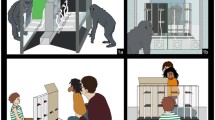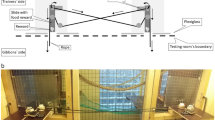Abstract
To examine the development of cooperation in a captive group of chimpanzees (Pan troglodytes), we designed an apparatus which required the simultaneous traction by two animals to get a reward. Two chimpanzees, an adult male and an infant female in a group of six, produced most of the successful responses (pulling on two handles simultaneously). Visual behavior was used to try to determine what chimpanzees learned about the cooperative task. Propositions were made to investigate what kind of learning could be attributed to chimpanzees and were confronted with results. Both subjects learned the link between the presence of fruits on the apparatus and the possibility of getting a fruit. They also learned the importance of the partner at the apparatus to make a successful response. Only the adult male learned to take into account the behavior of the partner at the apparatus before pulling a handle. From a methodological point of view, the glances made by the animals can constitute a useful behavioral indicator of what the subjects learned in a given social situation.
Similar content being viewed by others
References
Bard, K. A., 1990. “Social tool use” by free-ranging orangutans: a Piagetian and developmental perspective on manipulation of an animate object. In:“Language” and Intelligence in Monkeys and Apes: Comparative Developmental Perspectives,S. T. Parker &K. R. Gibson (eds.), Cambridge Univ. Press, Cambridge, pp. 356–378.
————, 1992. Intentional behavior and intentional communication in young free-ranging orangutans.Child Develop., 63: 1186–1197.
Beck, B. B., 1973. Cooperative tool use by captive Hamadryas baboons.Science, 182: 594–597.
Boesch, C. &H. Boesch, 1989. Hunting behavior of wild chimpanzees in the Taï national park.Amer. J. Phys. Anthropol., 78: 547–573.
Chalmeau, R., 1994. Do chimpanzees cooperate in a learning task?Primates, 35: 385–392.
———— &A. Gallo, 1993. Social constraints determine what is learned in the chimpanzee.Behav. Process, 28: 173–180.
———— & ————, 1994. Social influences on acquisition of a learning task in a captive group of chimpanzees. In:Current Primatology: Social Development, Learning and Behaviour,J. J. Roeder,B. Thierry,J. R. Anderson, &N. Herrenschmidt (eds.), Univ. Louis Pasteur, Strasbourg, pp. 347–353.
Dickinson, A., 1980.Contemporary Animal Learning Theory. Cambridge Univ. Press, London.
Jégat, R. &R. Chalmeau, 1992. Un dispositif pour réaliser des apprentissages en coopération chez des primates.Sci. Techn. Anim. Lab., 17: 121–125.
Menzel, E. W., 1972. Spontaneous invention of ladders in a group of young chimpanzees.Folia Primatol., 17: 87–106.
Petit, O., C. Desportes, &B. Thierry, 1992. Differential probability of “coproduction” in two species of macaque (Macaca tonkeana, M. mulatta).Ethology, 90: 107–120.
Povinelli, D. J., K. E. Nelson, &S. T. Boysen, 1992. Comprehension of role reversal in chimpanzees: evidence of empathy?Anim. Behav., 43: 633–640.
————,K. A. Parks, &M. A. Novak, 1991. Do rhesus monkeys (Macaca mulatta) attribute knowledge and ignorance to others?J. Comp. Psychol., 105: 318–325.
Savage-Rumbaugh, E. S., D. M. Rumbaugh, &S. Boysen, 1978. Symbolic communication between two chimpanzees.Science, 201: 641–644.
Visalberghi, E. &L. Trinca, 1989. Tool use in capuchin monkeys: distinguishing between performing and understanding.Primates, 30: 511–521.
Whiten, A. &R. W. Byrne, 1988. Tactical deception in primates.Behav. Brain Sci., 11: 233–273.
Woodruff, G. &D. Premack, 1979. Intentional communication in the chimpanzee: the development of deception.Cognition, 7: 333–362.
Author information
Authors and Affiliations
About this article
Cite this article
Chalmeau, R., Gallo, A. What chimpanzees (Pan troglodytes) learn in a cooperative task. Primates 37, 39–47 (1996). https://doi.org/10.1007/BF02382918
Received:
Accepted:
Issue Date:
DOI: https://doi.org/10.1007/BF02382918




